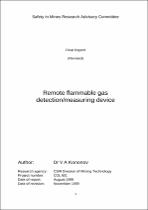JavaScript is disabled for your browser. Some features of this site may not work without it.
- ResearchSpace
- →
- Research Publications/Outputs
- →
- Conference Publications
- →
- View Item
| dc.contributor.author |
Drescher, K

|
|
| dc.date.accessioned | 2007-12-05T13:14:17Z | |
| dc.date.available | 2007-12-05T13:14:17Z | |
| dc.date.issued | 2002-02 | |
| dc.identifier.citation | Drescher, K. 2002. Investigation into the mechanisms of time dependent deformation of hard rocks. Safety in Mines Research advisory committee, GAP 601, February, 2002, pp 1-88 | en |
| dc.identifier.uri | http://hdl.handle.net/10204/1765 | |
| dc.description.abstract | The testing undertaken for this dissertation is intended to help quantify the various time-dependant deformation processes around typical deep level hard rock tabular excavations. Three mechanisms were investigated and two different hard rock types, Ventersdorp lava and Elsburg quartzite were used. Uniaxial compression creep studies were done as the first part of the study followed by shear creep studies on discontinuities were crushed lava and crushed quartzite as well as a natural gouge were used as infilling. An important conclusion made is that the relationship between grain size and infilling thickness is more important than previously might have been assumed. The last part of the study consisted of triaxial post-failure relaxation tests. As far as could be determined, this is the first time triaxial post-failure tests were attempted, particularly on typical South African hard rocks. An important finding of this study is that during compression creep as well as during triaxial post-failure relaxation the amount of energy dissipated for the lava is significantly less than for quartzite. For mines operating at great depth (more than 2000m) the implication is that the rock material might relax much more slowly than might have been assumed and this means that after failure the rock mass continues to store large amounts of strain energy. This study provides the first data available for energy change calculations in fractured rock masses. Three mechanisms of time-dependant deformation were quantified providing valuable data for numerical investigations. | en |
| dc.language.iso | en | en |
| dc.subject | SIMRAC | en |
| dc.subject | GAP 601 | en |
| dc.subject | Hard rocks | en |
| dc.subject | Deformation | en |
| dc.title | Investigation into the mechanisms of time dependent deformation of hard rocks. | en |
| dc.type | Conference Presentation | en |
| dc.identifier.apacitation | Drescher, K. (2002). Investigation into the mechanisms of time dependent deformation of hard rocks. http://hdl.handle.net/10204/1765 | en_ZA |
| dc.identifier.chicagocitation | Drescher, K. "Investigation into the mechanisms of time dependent deformation of hard rocks." (2002): http://hdl.handle.net/10204/1765 | en_ZA |
| dc.identifier.vancouvercitation | Drescher K, Investigation into the mechanisms of time dependent deformation of hard rocks; 2002. http://hdl.handle.net/10204/1765 . | en_ZA |
| dc.identifier.ris | TY - Conference Presentation AU - Drescher, K AB - The testing undertaken for this dissertation is intended to help quantify the various time-dependant deformation processes around typical deep level hard rock tabular excavations. Three mechanisms were investigated and two different hard rock types, Ventersdorp lava and Elsburg quartzite were used. Uniaxial compression creep studies were done as the first part of the study followed by shear creep studies on discontinuities were crushed lava and crushed quartzite as well as a natural gouge were used as infilling. An important conclusion made is that the relationship between grain size and infilling thickness is more important than previously might have been assumed. The last part of the study consisted of triaxial post-failure relaxation tests. As far as could be determined, this is the first time triaxial post-failure tests were attempted, particularly on typical South African hard rocks. An important finding of this study is that during compression creep as well as during triaxial post-failure relaxation the amount of energy dissipated for the lava is significantly less than for quartzite. For mines operating at great depth (more than 2000m) the implication is that the rock material might relax much more slowly than might have been assumed and this means that after failure the rock mass continues to store large amounts of strain energy. This study provides the first data available for energy change calculations in fractured rock masses. Three mechanisms of time-dependant deformation were quantified providing valuable data for numerical investigations. DA - 2002-02 DB - ResearchSpace DP - CSIR KW - SIMRAC KW - GAP 601 KW - Hard rocks KW - Deformation LK - https://researchspace.csir.co.za PY - 2002 T1 - Investigation into the mechanisms of time dependent deformation of hard rocks TI - Investigation into the mechanisms of time dependent deformation of hard rocks UR - http://hdl.handle.net/10204/1765 ER - | en_ZA |






